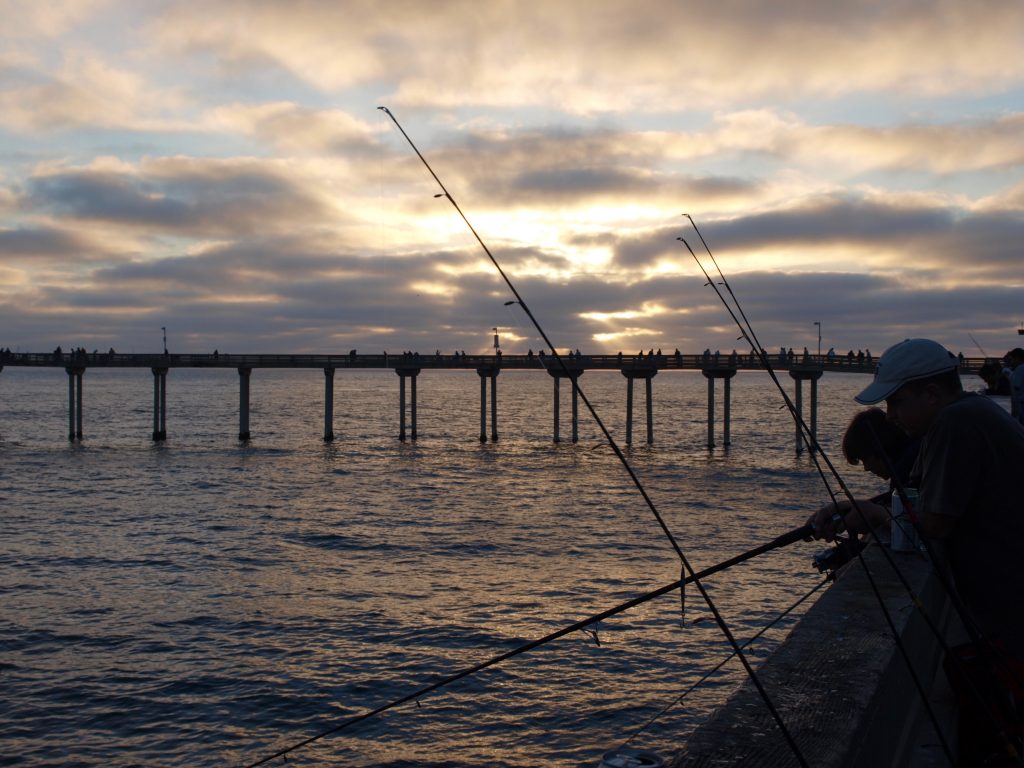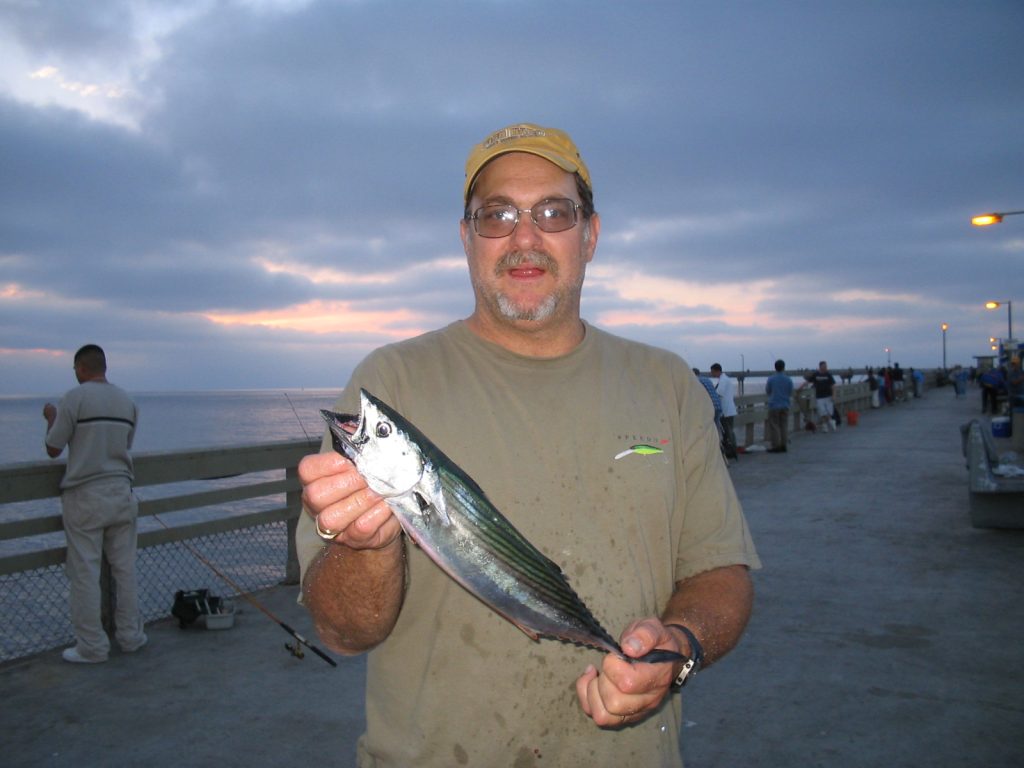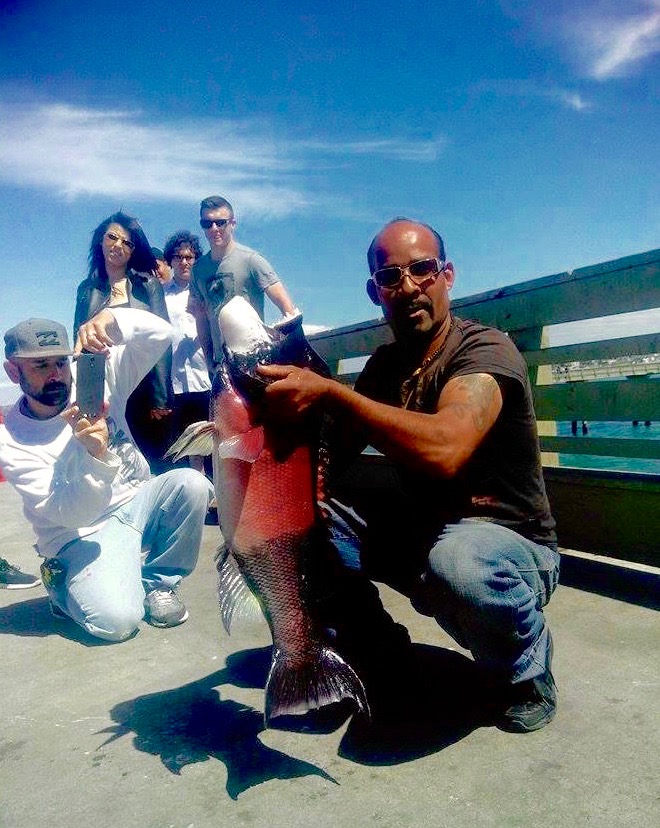Additional pelagic species include Pacific mackerel, jack mackerel and Pacific sardine. All may show up fairly close inshore all the way out to the end with the T-shaped end section usually producing the most fish.

The list is led by Pacific mackerel, one of the most common pier fish in SoCal. It can be found almost any time of the year although summer and fall are often key times. The most commonly used rigs are bait rigs, Sabiki or Lucky Lura, and Sabiki rigs with green colored feathers and size 6 to 10 (Japanese-size) hooks are the favorites for mackerel enthusiasts.
The mackerel will typically be at the top or near the top of the water and sometimes the macs are in a “mac attack” mode and will hit almost anything including bare hooks. Cast out your unbaited Sabiki rig, let it sink a few feet under the surface, and reel in the line with a medium-quick, herky-jerky motion. If no bites occur then you can add some bait to your hooks. The best bait is small pieces of mackerel or strips of squid on each hook making sure the piece only covers the hook and that the sharp pointed end of the hook is outside the fish. Cast out and slowly reel in the line. If the macs are in the right mood, you may hook a mackerel on every hook of the six-hook Sabiki.
Personally, I prefer to use a high/low rig with a couple of size 6 or 4 hooks. I don’t feel like spending time untangling a Sabiki containing 3-6 squirming and twisting mackerel. That often means a tangled mess and a rig almost impossible to fix. It can resemble a Gordian knot, one that requires an Alexander-like slice through the mess with a sword, or bait knife. Two macs at a time quickly fills the bait cooler and I see no sense in losing bait rigs if I can avoid it, they cost too much money ($2-4).
If the mackerel are in a light-biting mode, switch from the bait rig or a high/low to a single American size 4 hook on your line with a split-shot or twist-on sinker a few feet up the line. This rigging is a little harder to use here than at piers whose surfaces are closer to the water but it works fine if the wind and current aren’t too strong.
One final note on mackerel: they are a noted crepuscular species meaning that they are often most active during the “twilight” periods at sunrise and sunset. Frequently there will be an early morning bite and early evening bite. Arriving at 9 a.m. instead of 7 a.m. can be the difference between a bucket full of mackerel and no mackerel (and the macs may be absent throughout the day). A fish report taken mid-day would say no mackerel; one that surveyed morning and evening anglers would say great mackerel action. I’ve always said fish 6-8 a.m. and 6-8 p.m. (depending upon sunset) are great “mackerel times.”
At the same time mackerel will also often extend their twilight bite into the night. That’s when the regulars break out and attach a “glow stick” to their Sabiki rigs. They feel it helps attract the mackerel and it also allows them to see and follow their own lines better and avoid tangles.
The jack mackerel (Spanish mackerel) will also hit the Sabiki rigs but normally only one or two at a time.
Sardines may also show up (although they don’t show up every year). The standard rigging is one of the Sabiki-type bait rigs with fairly small hooks. You can also make your own bait rig; just string 4-6 shiny small, size 10 or 8 hooks on your line above a torpedo sinker. Just cast out and jig the line in the water. You don’t need bait or even colored yarn.
• End area—the widest section of the pier — the realm of the pelagic species and the larger sharays—sharks and rays.
At the far end of the pier, amongst the deepest water (20+ feet deep) and the kelp, is found an artificial 1/2 moon-shaped rock reef sitting out from the north end. It adds additional habitat for the fish. In this area are found some of the largest sport fish as well as kelp species that are rarely taken inshore.
As said, the pelagics are most common at the end. This is true with both Pacific mackerel, jack mackerel (Spanish mackerel), and the larger Pacific bonito. It’s also true when and if California yellowtail make a showing in the fall months.
Several bottom species are also most common at the end—kelp (calico) bass, barred sand bass, sheephead, and sculpin (scorpionfish), all species that seem attracted by the kelp. This is also the main area for spiny lobster.
Last but certainly not least, the end area is also the best area for the larger sharays (sharks and rays) and though all can also be caught in shallower areas, most of the largest sharks and rays seem to be caught at the end.
For the Pacific mackerel and jack mackerel use the information given above.
The bonito will be abundant some years and absent others. In the ‘60s they were almost too numerous and people would complain that they were crowding out the “better” fish. Then, when they did a disappearing act for many years, people lamented the loss of these great game fish. More recent decades have seen good years and bad years. Strangely, several of the last few years have seen runs of micro-bonito, small fish that were uncommon in the past. They’re supposed to spawn off of Baja and no one, including scientists that I talked to, seemed to know why baby bonito were showing up at SoCal piers. But, we’ll take them—and they grow fast!

When the medium to large-sized bonito show up, the best rigging seems to be a feather trailed behind a wooden bonito ball or Cast-a-Bubbler (a plastic bubble that is filed with water to give it weight), both are used as “splashers” to Some people even use old golf balls (with the appropriate swivels attached to them). Lately, more and more people are simply using lures, a great variety, for the boneheads. Included in the list of lures are MegaBaits, Crippled Herring, and even Buzz Bombs. Micro-sized bonito are young ‘uns and perhaps not as sharp, they will hit bait rigs (such as Sabiki rigs), often several at a time. But why, since you’re limited to five small bonito under 24-inches, use a bait rig? One cast might yield your limit.
The barracuda also like the end area but as mentioned will be found all the way down the pier to the bait shop area. Although they are most common at night (and there’s often a strong sunset bite) there can also be good daytime action depending upon how the schools of bait are hanging around the pier. Gold or silver-colored spoons (Krocodiles and Kastmasters) seem to work best but newer artificial lures like MegaBaits and Rebel Fast Tracks are also popular. Although most of the ‘cuda are under the 28-inch minimum length, 32-inch fish have been recorded.
Yellowtail is the favored trophy fish although most pier fisherman will never see or land one. Nevertheless, some yellowtail will show up most years, generally between July-October, and their appearance can quickly galvanize the pier rats into a state of apoplexy. Pier rats are soon tossing out whatever metal creations happen to be found in their tackle boxes, hoping to lure the ‘tails into their coveted section of water. The yellows for their part usually show just enough ‘tail to entice and tease the excited anglers. Then they disappear. Still it is fun while it lasts and adequate numbers are caught most years to keep the hope alive.
Several methods are time proven for the yellowtail: (1) Live bait, a still lively jack mackerel or Pacific mackerel (small) that you’ve caught with a bait rig. Use a sliding leader or a leader with a float. (2) A leadhead jig that has a strip of mackerel 1 1/2 inches long by 1/2 inch wide attached to the hook. (3) Artificial lures such as Crippled Anchovies, MegaBaits, Rebel Fast Tracks and Buzz Bombs. Among the yellowtail was a 50-pounder reported in November 2015. The most unusual story was in August 2007 when a hitchhiker yellowtail grabbed a hooked bonito; it didn’t want to let go but did so before the angler could bring it up to the pier; no such luck for the bonito.
Calico bass (kelp bass) sand bass, and sculpin (scorpionfish) are common out at the end while sand bass will make an occasional appearance. I have caught most of my kelp bass on a simple high/low with size 4 hooks and a torpedo sinker. I carefully fish the kelp fronds but also check out the pilings themselves, which yield a lot of the bass. I do keep my bait in motion—cast out and reel in slowly stopping every few turns. The bass like a moving bait. Bloodworms are great bait as are ghost shrimp and cut anchovies or pieces of mackerel. Sand bass will hit the same rigs and bait.
Unfortunately most of the bass are under the 14-inch minimum length (a lot of 10-12 inch fish) but not all are small ones. One unusual report on the calico bass came in July 2013 when Randy at the bait shop reported that “a lot of calico bass are being taken from almost the entire length of the pier.” The largest was a 26-inch fish that was the largest calico he had seen from the pier in ten years.
The sculpin (scorpionfish) bite best at night and like squid although when they are in the mood they will take a variety of baits. Wintertime is the prime time for the scorpies but fish will be caught year round. Again a high/low with number 4 hook torpedo sinker works well. I usually have my bait in motion but the sculpin (really a member of the scorpionfish/rockfish family and not a true sculpin) will also hit bait simply sitting motionless on the bottom. Do be careful when you catch one if you are a newbie to sculpin. The spines are poisonous and provide a nasty sting to the careless. Usually the best way to hold them is to grip them from the front of their mouth while removing the hook. They are well worth the effort since they are very good eating (but again be careful of the spines when cleaning the fish).
The left end corner sometimes sees the most kelp and seems the best spot for one of my favorite fish—sheephead, the red, black and white, a fish more common out on the party boats. Many of the buck-toothed critters have been taken here including a 15-pound fish in October ’09, a 20+-pound fish in September 2016, a 22 ½-pound fish (by Jose) in April 2017, and 13 and 17 pound sheephead in June 2019. Best bait for them seems to be either live ghost shrimp or pieces of market shrimp. The sheepies seem to hit best during the winter months but they can show up almost any month.

Many other species can show up out at the end. Many morey eels have been taken including a 4-foot-long moray in May of ’99 and a similar length eel in August 2007. 1999 saw a report of a large reddish-colored fish that remains unidentified. The area has produced a number of cabezon as well as rockfish—grass rockfish, kelp rockfish, brown rockfish, olive rockfish (Johnny bass) and treefish. The last decade has also seen a measurable increase in the number of salema and rock wrasse.